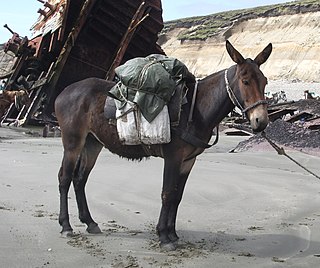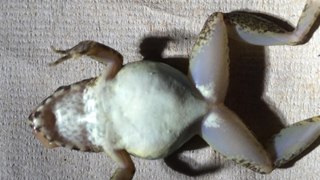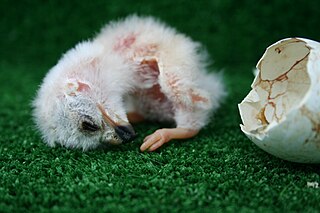Hybrid inviability is a post-zygotic barrier, which reduces a hybrid's capacity to mature into a healthy, fit adult. [1] The relatively low health of these hybrids relative to pure-breed individuals prevents gene flow between species. Thus, hybrid inviability acts as an isolating mechanism, limiting hybridization and allowing for the differentiation of species.
The mechanisms of reproductive isolation are a collection of evolutionary mechanisms, behaviors and physiological processes critical for speciation. They prevent members of different species from producing offspring, or ensure that any offspring are sterile. These barriers maintain the integrity of a species by reducing gene flow between related species.

In biology, a hybrid is the offspring resulting from combining the qualities of two organisms of different breeds, varieties, species or genera through sexual reproduction. Hybrids are not always intermediates between their parents, but can show hybrid vigour, sometimes growing larger or taller than either parent. The concept of a hybrid is interpreted differently in animal and plant breeding, where there is interest in the individual parentage. In genetics, attention is focused on the numbers of chromosomes. In taxonomy, a key question is how closely related the parent species are.

In population genetics, gene flow is the transfer of genetic variation from one population to another. If the rate of gene flow is high enough, then two populations are considered to have equivalent allele frequencies and therefore effectively be a single population. It has been shown that it takes only "One migrant per generation" to prevent populations from diverging due to drift. Gene flow is an important mechanism for transferring genetic diversity among populations. Migrants change the distribution of genetic diversity within the populations, by modifying the allele frequencies. High rates of gene flow can reduce the genetic differentiation between the two groups, increasing homogeneity. For this reason, gene flow has been thought to constrain speciation by combining the gene pools of the groups, thus preventing the development of differences in genetic variation that would have led to full speciation. In some cases migration may also result in the addition of novel genetic variants to the gene pool of a species or population.
The barrier of hybrid inviability occurs after mating species overcome pre-zygotic barriers (behavioral, mechanical, etc.) to produce a zygote. The barrier emerges from the cumulative effect of parental genes; these conflicting genes interfere with the embryo's development and prevents its maturation. Most often, the hybrid embryo dies before birth. However, sometimes, the offspring develops fully with mixed traits, forming a frail, often infertile adult. [2] This hybrid displays reduced fitness, marked by decreased rates of survival and reproduction relative to the parent species. The offspring fails to compete with purebred individuals, limiting genes flow between species. [3]

A zygote is a eukaryotic cell formed by a fertilization event between two gametes. The zygote's genome is a combination of the DNA in each gamete, and contains all of the genetic information necessary to form a new individual. In multicellular organisms, the zygote is the earliest developmental stage. In single-celled organisms, the zygote can divide asexually by mitosis to produce identical offspring.

An embryo is an early stage of development of a multicellular diploid eukaryotic organism. In general, in organisms that reproduce sexually, an embryo develops from a zygote, the single cell resulting from the fertilization of the female egg cell by the male sperm cell. The zygote possesses half the DNA from each of its two parents. In plants, animals, and some protists, the zygote will begin to divide by mitosis to produce a multicellular organism. The result of this process is an embryo.
Infertility is the inability of a person, animal or plant to reproduce by natural means. It is usually not the natural state of a healthy adult, except notably among certain eusocial species.
Evolution of Hybrid Inviability in Tetrapods
In the 1970s, Allan C. Wilson and his colleagues first investigated the evolution of hybrid inviability in tetrapods, specifically mammals, birds, and frogs. [4] [5]

Tetrapods (from Greek: τετρα- "four" and πούς "foot") are four-limbed animals constituting the superclass Tetrapoda. It includes existing and extinct amphibians, reptiles, and mammals. Tetrapods evolved from a group of animals known as the Tetrapodomorpha which, in turn, evolved from ancient Sarcopterygii around 390 million years ago in the middle Devonian period; their forms were transitional between lobe-finned fishes and the four-limbed tetrapods. The first tetrapods appeared by the late Devonian, 367.5 million years ago; the specific aquatic ancestors of the tetrapods, and the process by which they colonized Earth's land after emerging from water remains unclear. The change from a body plan for breathing and navigating in water to a body plan enabling the animal to move on land is one of the most profound evolutionary changes known. The first tetrapods were primarily aquatic. Modern amphibians, which evolved from earlier groups, are generally semiaquatic; the first stage of their lives is as fish-like tadpoles, and later stages are partly terrestrial and partly aquatic. However, most tetrapod species today are amniotes, most of those are terrestrial tetrapods whose branch evolved from earlier tetrapods about 340 million years ago. The key innovation in amniotes over amphibians is laying of eggs on land or having further evolved to retain the fertilized egg(s) within the mother.

Mammals are vertebrate animals constituting the class Mammalia, and characterized by the presence of mammary glands which in females produce milk for feeding (nursing) their young, a neocortex, fur or hair, and three middle ear bones. These characteristics distinguish them from reptiles and birds, from which they diverged in the late Triassic, 201–227 million years ago. There are around 5,450 species of mammals. The largest orders are the rodents, bats and Soricomorpha. The next three are the Primates, the Cetartiodactyla, and the Carnivora.

Birds, also known as Aves, are a group of endothermic vertebrates, characterised by feathers, toothless beaked jaws, the laying of hard-shelled eggs, a high metabolic rate, a four-chambered heart, and a strong yet lightweight skeleton. Birds live worldwide and range in size from the 5 cm (2 in) bee hummingbird to the 2.75 m (9 ft) ostrich. They rank as the world's most numerically-successful class of tetrapods, with approximately ten thousand living species, more than half of these being passerines, sometimes known as perching birds. Birds have wings which are more or less developed depending on the species; the only known groups without wings are the extinct moa and elephant birds. Wings, which evolved from forelimbs, gave birds the ability to fly, although further evolution has led to the loss of flight in flightless birds, including ratites, penguins, and diverse endemic island species of birds. The digestive and respiratory systems of birds are also uniquely adapted for flight. Some bird species of aquatic environments, particularly seabirds and some waterbirds, have further evolved for swimming.
Recognizing that hybrid viability decreases with time, the researchers used molecular clocks to quantify divergence time. They identified how long ago the common ancestor of hybridizing species diverged into two lines, and found that bird and frog species can produce viable hybrids up to twenty million years after speciation. In addition, the researchers showed that mammal species can only produce viable hybrids up to two or three million years after speciation.

The molecular clock is figurative term for a technique that uses the mutation rate of biomolecules to deduce the time in prehistory when two or more life forms diverged. The biomolecular data used for such calculations are usually nucleotide sequences for DNA or amino acid sequences for proteins. The benchmarks for determining the mutation rate are often fossil or archaeological dates. The molecular clock was first tested in 1962 on the hemoglobin protein variants of various animals, and is commonly used in molecular evolution to estimate times of speciation or radiation. It is sometimes called a gene clock or an evolutionary clock.

In vector calculus, divergence is a vector operator that produces a scalar field, giving the quantity of a vector field's source at each point. More technically, the divergence represents the volume density of the outward flux of a vector field from an infinitesimal volume around a given point.

Speciation is the evolutionary process by which populations evolve to become distinct species. The biologist Orator F. Cook coined the term in 1906 for cladogenesis, the splitting of lineages, as opposed to anagenesis, phyletic evolution within lineages. Charles Darwin was the first to describe the role of natural selection in speciation in his 1859 book The Origin of Species. He also identified sexual selection as a likely mechanism, but found it problematic.
Wilson et al. (1974) proposes two hypotheses to explain the relatively faster evolution of hybrid inviability in mammals: the Regulatory and the Immunological Hypotheses. Subsequent research finds support for these hypotheses.

A hypothesis is a proposed explanation for a phenomenon. For a hypothesis to be a scientific hypothesis, the scientific method requires that one can test it. Scientists generally base scientific hypotheses on previous observations that cannot satisfactorily be explained with the available scientific theories. Even though the words "hypothesis" and "theory" are often used synonymously, a scientific hypothesis is not the same as a scientific theory. A working hypothesis is a provisionally accepted hypothesis proposed for further research, in a process beginning with an educated guess or thought.

Evolution is change in the heritable characteristics of biological populations over successive generations. These characteristics are the expressions of genes that are passed on from parent to offspring during reproduction. Different characteristics tend to exist within any given population as a result of mutation, genetic recombination and other sources of genetic variation. Evolution occurs when evolutionary processes such as natural selection and genetic drift act on this variation, resulting in certain characteristics becoming more common or rare within a population. It is this process of evolution that has given rise to biodiversity at every level of biological organisation, including the levels of species, individual organisms and molecules.
The Regulatory Hypothesis accounts for two characteristics of mammals, and explains the general formation of hybrid inviability in mammals, birds, and frogs.
First, mammals display relatively lower protein diversity than frogs. As Wilson et al. (1974) suggests, “mammals that can hybridize with each other differ only slightly at the protein level, whereas frogs that differ substantially in protein sequence hybridize readily.” This analysis suggests that gene divergence is not the only determinate of hybridization in mammals, birds, or frogs.
Second, the evolution of anatomical diversity occurred far faster in mammals than in either birds or frogs. As Fitzpatrick (2004) indicates, “the morphological disparities among bats, mole-rats, and whales are more dramatic than any disparities in birds and frogs.” This anatomical diversity is evidence for the diversification of regulatory systems. This mammalian characteristic suggests that, although mammals are genetically similar, dramatic changes in regulatory genes caused distinct developmental differences. [6]
The Regulatory Hypotheses specifically attributes hybrid inviability in mammals, birds, and frogs to differences in gene regulation. It proposes that hybrid inviability evolved faster in mammalian taxa because mammals have accumulated significantly more changes in regulatory systems than birds or frogs, and it suggests that organisms with distinctly different systems of gene regulation may not produce viable hybrids.
Wilson et al. (1974) recognizes that the development of embryos in the mammalian placenta requires regulatory compatibility. Both the regulatory genes of the sperm and egg contribute to the expression of other protein-coding genes in the zygote; if certain regulatory genes are not expressed or are expressed at the wrong time, the inter-specific zygote will abort or develop unhealthy traits. Moreover, because the development of the zygote depends on maternal characteristics, such as cytoplasmic determinants, the regulatory traits of the mother may not support the hybrid's developmental needs.
The Immunological Hypothesis proposes that the divergence of certain protein structures associated with mother and child causes hybrid inviability. The hypothesis applies only to mammals, where fertilization and development is internal. In birds and in frogs, fertilization is primarily external, and the mother’s immune system does not interfere with fetal development.
This hypothesis stems from the immunological characteristics of the placenta, where the growing fetus is in constant contact with the fluids and tissues of the mother. Variation within species and variation between species may contribute to fetal-maternal incompatibility, and according to the hypothesis, if the proteins of the fetus varies significantly from the proteins of the placenta, the mother may produce anti-bodies that will attack and abort the fetus. Therefore, if the fetal proteins of the father species are incompatible the mother's placental proteins, the mother's immune system may abort the embryo.
Evidence for the Immunological Hypothesis varies considerably. Wilson et al. (1974) recognizes studies that provide no support to the Immunological Hypotheses. In these experiments, the use of immunological suppressants provided no additional viability to inter-specific hybrids. In contrast, Elliot and Crespi (2006) documents the effects of placental immunology on hybrid inviability, showing that mammals with hemochorial placentas more readily hybridize than mammals with epitheliochorial or endotheliochorial placentas. These different placenta types possess divergent immunological systems, and consequently, they cause varying degrees of hybrid inviability. [7]
Gestation is the period of development during the carrying of an embryo or fetus inside viviparous animals. It is typical for mammals, but also occurs for some non-mammals. Mammals during pregnancy can have one or more gestations at the same time for example in a multiple birth.
Genomic imprinting is an epigenetic phenomenon that causes genes to be expressed in a parent-of-origin-specific manner. Forms of genomic imprinting have been demonstrated in fungi, plants and animals. As of 2014, there are about 150 imprinted genes known in the mouse and about half that in humans.

The placenta is a temporary organ that connects the developing fetus via the umbilical cord to the uterine wall to allow nutrient uptake, thermo-regulation, waste elimination, and gas exchange via the mother's blood supply; to fight against internal infection; and to produce hormones which support pregnancy. Placentas are a defining characteristic of placental mammals, but are also found in marsupials and some non-mammals with varying levels of development.
Human development is the process of growth to maturity. The process begins with fertilisation, where an egg released from the ovary of a female is penetrated by a sperm cell from a male. The egg then lodges in the uterus, where an embryo and later fetus develop until birth. Further growth and development continues after birth, and includes both physical and psychological development, influenced by genetic, hormonal, environmental and other factors. This continues throughout life, through childhood, and adolescence into adulthood.

The amnion is a membrane that closely covers the embryo when first formed. It fills with the amniotic fluid which causes the amnion to expand and become the amniotic sac which serves to provide a protective environment for the developing embryo or fetus. The amnion, along with the chorion, the yolk sac and the allantois form a protective sac around the embryo. In birds, reptiles and monotremes, the protective sac is enclosed in a shell. In marsupials and placental mammals, it is enclosed in a uterus.

The chorion is the outermost fetal membrane around the embryo in mammals, birds and reptiles. It develops from an outer fold on the surface of the yolk sac, which lies outside the zona pellucida, known as the vitelline membrane in other animals. In insects it is developed by the follicle cells while the egg is in the ovary.

Theria is a subclass of mammals amongst the Theriiformes. Theria includes the eutherians and the metatherians.

Among animals, viviparity is development of the embryo inside the body of the parent, eventually leading to live birth, as opposed to reproduction by laying eggs that complete their incubation outside the parental body.

Ovoviviparity, ovovivipary, ovivipary, or aplacental viviparity is a mode of reproduction in animals in which embryos that develop inside eggs remain in the mother's body until they are ready to hatch. This method of reproduction is similar to viviparity, but the embryos have no placental connection with the mother and receive their nourishment from a yolk sac. In some species, this is supplemented by uterine secretions or other maternal provisioning.

The egg is the organic vessel containing the zygote in which an embryo develops until it can survive on its own; at which point the animal hatches. An egg results from fertilization of an egg cell. Most arthropods, vertebrates, and mollusks lay eggs, although some, such as scorpions do not.

Haldane's rule is an observation about the early stage of speciation, formulated in 1922 by the British evolutionary biologist J.B.S. Haldane, that states that if in a species hybrid only one sex is inviable or sterile, that sex is more likely to be the heterogametic sex. The heterogametic sex is the one with two different sex chromosomes; in therian mammals, for example, this is the male.

Gestational hypertension or pregnancy-induced hypertension (PIH) is the development of new hypertension in a pregnant woman after 20 weeks' gestation without the presence of protein in the urine or other signs of pre-eclampsia. Gestational Hypertension is defined as having a blood pressure
greater than 140/90 on two separate occasions at least 6 hours apart.
Parent–offspring conflict (POC) is an expression coined in 1974 by Robert Trivers. It is used to describe the evolutionary conflict arising from differences in optimal parental investment (PI) in an offspring from the standpoint of the parent and the offspring. PI is any investment by the parent in an individual offspring that decreases the parent's ability to invest in other offspring, while the selected offspring's chance of surviving increases.

In biology, placentation refers to the formation, type and structure, or arrangement of the placenta. The function of placentation is to transfer nutrients, respiratory gases, and water from maternal tissue to a growing embryo, and in some instances to remove waste from the embryo. Placentation is best known in live-bearing mammals (theria), but also occurs in some fish, reptiles, amphibians, a diversity of invertebrates, and flowering plants. In vertebrates, placentas have evolved more than 100 times independently, with the majority of these instances occurring in squamate reptiles.
Interspecific pregnancy is the pregnancy involving an embryo or fetus belonging to another species than the carrier. Strictly, it excludes the situation where the fetus is a hybrid of the carrier and another species, thereby excluding the possibility that the carrier is the biological mother of the offspring. Strictly, interspecific pregnancy is also distinguished from endoparasitism, where parasite offspring grow inside the organism of another species, not necessarily in the womb.
Immune tolerance in pregnancy or maternal immune tolerance is the immune tolerance shown towards the fetus and placenta during pregnancy. This tolerance counters the immune response that would normally result in the rejection of something foreign in the body, as can happen in cases of spontaneous abortion. It is studied within the field of reproductive immunology.

Most mammals are viviparous, giving birth to live young. However, the five species of monotreme, the platypuses and the echidnas, lay eggs. The monotremes have a sex determination system different from that of most other mammals. In particular, the sex chromosomes of a platypus are more like those of a chicken than those of a therian mammal.

Pregnancy has been traditionally defined as the period during which developing embryos are incubated in the body after egg-sperm union. Although the term often refers to placental mammals, it has also been used in the titles of many international, peer-reviewed, scientific articles on fish, e.g. Consistent with this definition, there are several modes of reproduction in fish, providing different amounts of parental care. In ovoviviparity, there is internal fertilization and the young are born live but there is no placental connection or significant trophic (feeding) interaction; the mother's body maintains gas exchange but the unborn young are nourished by egg yolk. There are two types of viviparity in fish. In histotrophic viviparity, the zygotes develop in the female's oviducts, but she provides no direct nutrition; the embryos survive by eating her eggs or their unborn siblings. In hemotrophic viviparity, the zygotes are retained within the female and are provided with nutrients by her, often through some form of placenta.

Animals make use of a variety of modes of reproduction to produce their young. Traditionally this variety was classified into three modes, oviparity, viviparity, and ovoviviparity.




















